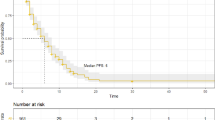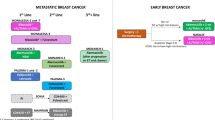Abstract
The insulin-like growth factor I receptor (IGF1R) interacts with estrogen receptor-α (ERα) and HER2. We examined the effect of combinations of IGF1R antagonists (α-IR3, AG1024) and anti-estrogens (4-hydroxy tamoxifen, fulvestrant) in two human ER+ breast cancer cell lines: BT474 (HER2 overexpressing, IGF1R low) and MCF7 (HER2 non-overexpressing, IGF1R high). In BT474 cells, growth was inhibited by anti-estrogens, but not by IGF1R antagonists; however, adding IGF1R inhibitors to anti-estrogens enhanced growth inhibition. In MCF7 cells, growth was inhibited by IGF1R and ER antagonists and more so by their combination. In both cell lines, no single agents could induce apoptosis, but combining IGF1R inhibitors with anti-estrogens induced dramatic levels of apoptosis. IGF1R antagonists enhanced the ability of the anti-estrogens to inhibit ER transcriptional activity in BT474 cells, but not in MCF7 cells. The drug combination synergistically inhibited ER and IGF1R activity. Such combinations may be useful therapy for breast cancer.






Similar content being viewed by others
References
Argiris A, Wang C-X, Whalen SG, DiGiovanna MP (2004) Synergistic interactions between tamoxifen and trastuzumab (Herceptin). Clin Cancer Res 10:1409–1420. doi:10.1158/1078-0432.CCR-1060-02
Wang C-X, Koay DC, Edwards A et al (2005) In vitro and in vivo effects of combination of trastuzumab (Herceptin) and tamoxifen in breast cancer. Breast Cancer Res Treat 92:251–263. doi:10.1007/s10549-005-3375-z
Baserga R (2004) Targeting the IGF-1 receptor: from rags to riches. Eur J Cancer 40:2013–2015. doi:10.1016/j.ejca.2004.06.015
Huynh H, Nickerson T, Pollak M, Yang X (1996) Regulation of insulin-like growth factor I receptor expression by the pure antiestrogen ICI 182780. Clin Cancer Res 2(12):2037–2042
Kato S, Endoh H, Masuhiro Y et al (1995) Activation of the estrogen receptor through phosphorylation by mitogen-activated protein kinase. Science 270:1491–1494. doi:10.1126/science.270.5241.1491
Lee AV, Jackson JG, Gooch JL et al (1999) Enhancement of insulin-like growth factor signaling in human breast cancer: estrogen regulation of insulin receptor substrate-1 expression in vitro and in vivo. Mol Endocrinol 13(5):787–796. doi:10.1210/me.13.5.787
Lee AV, Weng CN, Jackson JG, Yee D (1997) Activation of estrogen receptor-mediated gene transcription by IGF-I in human breast cancer cells. J Endocrinol 152(1):39–47. doi:10.1677/joe.0.1520039
Balañá ME, Labriola L, Salatino M et al (2001) Activation of ErbB-2 via a hierarchical interaction between ErbB-2 and type I insulin-like growth factor receptor in mammary tumor cells. Oncogene 20:34–47. doi:10.1038/sj.onc.1204050
Balañá ME, Lupu R, Labriola L, Charreau EH, Elizalde PV (1999) Interactions between progestins and heregulin (HRG) signaling pathways: HRG acts as mediator of progestins proliferative effects in mouse mammary adenocarcinomas. Oncogene 18:6370–6379. doi:10.1038/sj.onc.1203028
Camirand A, Lu Y, Pollak M (2002) Co-targeting HER2/ErbB2 and insulin-like growth factor-1 receptors causes synergistic inhibition of growth in HER2-overexpressing breast cancer cells. Med Sci Monit 8(12):BR521–BR526
Camirand A, Zakikhani M, Young F, Pollak M (2005) Inhibition of insulin-like growth factor-1 receptor signaling enhances growth-inhibitory and proapoptotic effects of gefitinib (Iressa) in human breast cancer cells. Breast Cancer Res 7:R570–R579. doi:10.1186/bcr1028
Lu YH, Zi XL, Zhao YH, Mascarenhas D, Pollak M (2001) Insulin-like growth factor-I receptor signaling and resistance to trastuzumab (Herceptin). J Natl Cancer Inst 93(4):1852–1857. doi:10.1093/jnci/93.24.1852
Nahta R, Yuan LXH, Zhang B, Kobayashi R, Esteva FJ (2005) Insulin-like growth factor-I receptor/human epidermal growth factor receptor 2 heterodimerization contributes to trastuzumab resistance of breast cancer cells. Cancer Res 65(23):11118–11128. doi:10.1158/0008-5472.CAN-04-3841
Happerfield LC, Miles DW, Barnes DM, Thomsen LL, Smith P, Hanby A (1997) The localization of the insulin-like growth factor receptor 1 (IGFR-1) in benign and malignant breast tissue. J Pathol 183(4):412–417. doi:10.1002/(SICI)1096-9896(199712)183:4<412::AID-PATH944>3.0.CO;2-4
Fürsenberger G, Morant R, Senn HJ (2003) Insulin-like growth factors and breast cancer. Onkologie 26:290–294. doi:10.1159/000071627
Kahlert S, Neudling S, van Eickels M, Vetter H, Meyer R, Grohe C (2000) Estrogen receptor alpha rapidly activates the IGF-1 receptor pathway. J Biol Chem 275(24):18447–18453. doi:10.1074/jbc.M910345199
Martin MB, Franke TF, Stoica GE et al (2000) A role for Akt in mediating the estrogenic functions of epidermal growth factor and insulin-like growth factor I. Endocrinology 141(12):4503–4511. doi:10.1210/en.141.12.4503
Song RX, Barnes CJ, Zhang ZG, Bao YD, Kumar R, Santen RJ (2004) The role of Shc and insulin-like growth factor I receptor in mediating the translocation of estrogen receptor α to the plasma membrane. Proc Natl Acad Sci USA 101(7):2076–2081. doi:10.1073/pnas.0308334100
Migliaccio A, Di Domenico M, Castoria G et al (1996) Tyrosine kinase/p21ras/MAP-kinase pathway activation by estradiol-receptor complex in MCF-7 cells. EMBO J 15(6):1292–1300
Migliaccio A, Domenico P, Castoria G et al (1998) Activation of the Src/p21ras/Erk pathway by progesterone receptor via cross-talk with estrogen receptor. EMBO J 17(7):2008–2018. doi:10.1093/emboj/17.7.2008
Santen RJ, Jeng MH, Wang JP et al (2001) Adaptive hypersensivity to estradiol: potential mechanism for secondary hormonal responses in breast cancer patients. J Steroid Biochem Mol Biol 79((1-5 Speciall Issue SI)):115–125
Song RXD, McPherson RA, Adam L et al (2002) Linkage of rapid estrogen action to MAPK activation by ER alpha-Shc association and Shc pathway activation. Mol Endocrinol 16(1):116–127. doi:10.1210/me.16.1.116
Zhang ZG, Maier B, Santen RJ, Song RXD (2002) Membrane association of estrogen receptor alpha mediates estrogen effect on MAPK activatioin. Biochem Biophys Res Commun 294(5):926–933. doi:10.1016/S0006-291X(02)00348-0
Hankinson SE, Willett WC, Colditz GA et al (1998) Circulating concentrations of insulin-like growth factor-I and risk of breast cancer. Lancet 351(9113):1393–1396. doi:10.1016/S0140-6736(97)10384-1
Byrne C, Colditz GA, Willett WC, Speizer FE, Pollak M, Hankinson SE (2000) Plasma insulin-like growth factor (IGF) I, IGF-binding protein 3, and mammographic density. Cancer Res 60:3744–3748
Decensi A, Robertson C, Ballardini B et al (1999) Effect of tamoxifen on lipoprotein(a) and insulin-like growth factor-I (IGF-I) in healthy women. Eur J Cancer 35(4):596–600. doi:10.1016/S0959-8049(98)00428-6
Ho GH, Ji CY, Phang BH, Lee KO, Soo KC, Ng EH (1998) Tamoxifen alters levels of serum insulin-like growth factors and binding proteins in postmenopausal breast cancer patients: a prospective paired cohort study. Ann Surg Oncol 5(4):361–367. doi:10.1007/BF02303501
Chakraborty AK, Liang K, DiGiovanna MP (2008) Co-targeting insulin-like growth factor I receptor and HER2: dramatic effects of HER2 inhibitors on nonoverexpressing breast cancer. Cancer Res 68:1538–1545. doi:10.1158/0008-5472.CAN-07-5935
Neve RM, Chin K, Fridlyand J et al (2006) A collection of breast cancer cell lines for the study of functionally distinct cancer subtypes. Cancer Cell 10:515–527. doi:10.1016/j.ccr.2006.10.008
Acknowledgments
Supported by grants from the Breast Cancer Research Foundation to MPD. We thank Dr. Marc Lippman for MCF7 cells and advice on their use, Dr. Rocco Carbone of the Yale Cancer Center Flow Cytometry shared resource (supported by US Public Health Service grant CA-16359 from the National Cancer Institute) for assistance with flow cytometry, and Cynthia Zerillo for helpful suggestions.
Author information
Authors and Affiliations
Corresponding author
Rights and permissions
About this article
Cite this article
Chakraborty, A.K., Welsh, A. & DiGiovanna, M.P. Co-targeting the insulin-like growth factor I receptor enhances growth-inhibitory and pro-apoptotic effects of anti-estrogens in human breast cancer cell lines. Breast Cancer Res Treat 120, 327–335 (2010). https://doi.org/10.1007/s10549-009-0382-5
Received:
Accepted:
Published:
Issue Date:
DOI: https://doi.org/10.1007/s10549-009-0382-5




